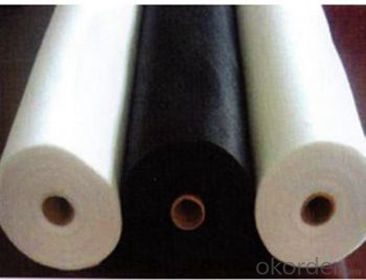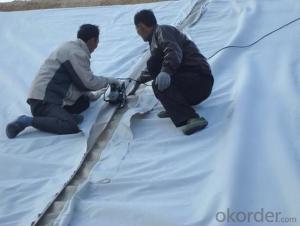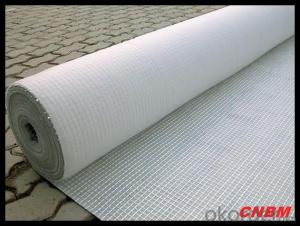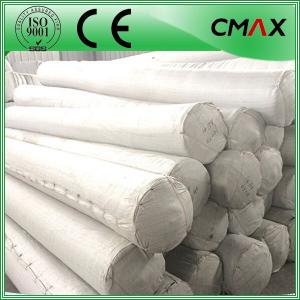Non-Woven Geotextile Needle Punched PP for Reinforcement and Drainage
- Loading Port:
- China main port
- Payment Terms:
- TT OR LC
- Min Order Qty:
- 4000 g/m²
- Supply Capability:
- 1000000 g/m²/month
OKorder Service Pledge
OKorder Financial Service
You Might Also Like
Specification

Filtration:
It can be the filtration layer of the dykes, river canal, seacoast, concrete slope, retaining walls. At the same time of preventing the clay granule from passing, it allows the water and the gas pass through freely.
Separation:
The isolation of the railway dregs and the roadbed, roadbed and the soft base, surface of the airdrome and parking lot and the groundsill, different dam materials. It isolates the soil and the gravel of two kinds different granule pathway from the groundsill or other buildings.
Reinforcement:
The highway, railway, soil-stone dam, breakwater, airport, backfill soil of retaining wall, slope protection, etc in which distributes the earth stress, prevents the side-displacement of the earth body and improves the earthbody stability. 
1. short fiber needle punched nonwoven geotextiles (heat set or not) Pet short fiber
2. different color nonwoven geotextile
3. The product has the property of anti-aging, high strength, good flexibility and permeability, filtration, isolation and easy construction
4. It is widely used in areas of the railway, highway, sport venue,dyke,water project construction, tunnel,sea beach,inning,environment protection and so on. It can also used in the reinforcement, separation,filtration,drainage ect.
FAQ:
Q: What kind of payments does jenor support?
A: T/T, L/C, Cash are accepted.
Q: Do you charge for the samples?
A: Accordeing to our company policy, the samples are free, we only charge the freight fee. And we will return the freight fee during the next order.
Q: Can you produce according to customers' design?
A: Sure, we are professional manufacturer, OEM and ODM are both welcome.
Q: Do you have other products?
A: Yes, please check the pictures:
- Q: Are geotextiles suitable for use in wetlands?
- Yes, geotextiles are suitable for use in wetlands. They are commonly used to stabilize soil, control erosion, and promote vegetation growth in wetland areas. Geotextiles can help retain moisture, filter water, and provide support to prevent soil movement. Additionally, they are often biodegradable or made from natural materials, making them environmentally friendly and suitable for use in wetland ecosystems.
- Q: Are geotextiles used in landfill construction?
- Yes, geotextiles are commonly used in landfill construction. They serve several purposes such as preventing soil erosion, stabilizing slopes, and facilitating drainage. Geotextiles also help to separate different layers of soil and prevent the mixing of waste materials with the surrounding soils.
- Q: How do geotextiles help with erosion control in river channels?
- Geotextiles aid in erosion control in river channels by acting as a protective barrier against soil erosion. They are placed along the riverbanks or riverbeds to prevent the loss of soil particles due to water flow. Geotextiles stabilize the soil, increase its resistance to erosion, and promote vegetation growth. Additionally, they allow water to pass through while retaining sediment, thus reducing sedimentation in the river channel.
- Q: Can geotextiles be used in land reclamation projects?
- Yes, geotextiles can be used in land reclamation projects. Geotextiles are commonly used in these projects to stabilize and reinforce soil, control erosion, and promote vegetation growth, ultimately enhancing the overall success and durability of the reclaimed land.
- Q: Are geotextiles resistant to rodent penetration?
- Yes, geotextiles are generally resistant to rodent penetration.
- Q: Are geotextiles suitable for use in stormwater management systems?
- Yes, geotextiles are suitable for use in stormwater management systems. They can effectively filter and separate soil particles, prevent soil erosion, and enhance water infiltration rates. Additionally, geotextiles can provide reinforcement and stabilization to prevent sedimentation and clogging in stormwater systems, making them a valuable component in stormwater management practices.
- Q: How do geotextiles prevent soil contamination?
- Geotextiles prevent soil contamination by acting as a barrier between the soil and potential contaminants, such as pollutants or waste materials. They prevent the migration of contaminants into the soil by providing a physical barrier that filters out harmful substances and allows only clean water to pass through. Additionally, geotextiles can enhance the stability and strength of the soil, reducing the risk of erosion and preventing the spread of contaminated soil to surrounding areas.
- Q: Geotextile 150 * 0.5 * 150 on behalf of what
- This is the composite geomembrane specifications are two cloth a film, 150 grams of geotextile is 0.5MM in the middle of the film, the following is 150 grams of geotextile, compound into
- Q: Are geotextiles suitable for use in groundwater remediation systems?
- Yes, geotextiles are suitable for use in groundwater remediation systems. Geotextiles can serve as effective filters and barriers, preventing the migration of contaminants while allowing for the flow of water. They can be used to line trenches and basins, as well as to create permeable reactive barriers, enhancing the efficiency of remediation efforts by controlling and directing groundwater flow. Additionally, geotextiles are durable and resistant to chemical degradation, making them well-suited for long-term use in groundwater remediation systems.
- Q: Are geotextiles suitable for use in erosion control mats for revegetation?
- Yes, geotextiles are suitable for use in erosion control mats for revegetation. Geotextiles are designed to prevent soil erosion by stabilizing the soil and promoting vegetation growth. They provide a protective layer that allows water to pass through while retaining soil particles, which helps to reduce erosion. Additionally, geotextiles facilitate the establishment of vegetation by providing a favorable environment for root development. Overall, geotextiles are an effective solution for erosion control in revegetation projects.
Send your message to us
Non-Woven Geotextile Needle Punched PP for Reinforcement and Drainage
- Loading Port:
- China main port
- Payment Terms:
- TT OR LC
- Min Order Qty:
- 4000 g/m²
- Supply Capability:
- 1000000 g/m²/month
OKorder Service Pledge
OKorder Financial Service
Similar products
Hot products
Hot Searches
Related keywords






























